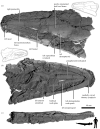Giant gar from directly above the Cretaceous-Palaeogene boundary suggests healthy freshwater ecosystems existed within thousands of years of the asteroid impact
- PMID: 35702983
- PMCID: PMC9198771
- DOI: 10.1098/rsbl.2022.0118
Giant gar from directly above the Cretaceous-Palaeogene boundary suggests healthy freshwater ecosystems existed within thousands of years of the asteroid impact
Abstract
The Cretaceous-Palaeogene (K-Pg) mass extinction was responsible for the destruction of global ecosystems and loss of approximately three-quarters of species diversity 66 million years ago. Large-bodied land vertebrates suffered high extinction rates, whereas small-bodied vertebrates living in freshwater ecosystems were buffered from the worst effects. Here, we report a new species of large-bodied (1.4-1.5 m) gar based on a complete skeleton from the Williston Basin of North America. The new species was recovered 18 cm above the K-Pg boundary, making it one of the oldest articulated vertebrate fossils from the Cenozoic. The presence of this freshwater macropredator approximately 1.5-2.5 thousand years after the asteroid impact suggests the rapid recovery and reassembly of North American freshwater food webs and ecosystems after the mass extinction.
Keywords: Fish; K–Pg; Lepisosteidae; Lilliput effect; gar.
Figures


References
MeSH terms
Associated data
LinkOut - more resources
Full Text Sources

